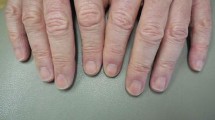Abstract
Radiation recall is a phenomenon commonlyseen in patients receiving chemotherapytreatment who have previously been exposedto radiation. A phenomenon not clearlydescribed is that of a side effect inducedby one chemotherapy agent and laterrecalled when the patient is given adifferent chemotherapy regimen. Troxacitabine is an anti-leukemic agentwhich can be associated with palmar-plantarerythrodysesthesia syndrome (PPES). Here,we report six cases oftroxacitabine-induced PPES that was laterrecalled by various chemotherapy regimens. The recall PPES was mild to moderate andself-limiting in all cases. All of thesepatients recovered from the recall sideeffects with minimal medical intervention. We conclude that a recall phenomenonsimilar to that described afterradiotherapy might occur after certainchemotherapy agents. This phenomenonshould be considered when evaluatingtoxicity from chemotherapy, particularlywhen using new and investigationalagents.
Similar content being viewed by others
References
Kellie SJ, Plowman PN, Malpas JS: Radiation recall and radiosensitization with alkylating agents. Lancet 1: 1149–1150, 1987
McInerney DP, Bullimore J: Reactivation of radiation pneumonitis by adriamycin. Brit J Rad 50: 224–227, 1977
Muggia FM, Louie AC, Sikic BI: Pulmonary toxicity of antitumor agents. Cancer Treat Rev 10: 221–243, 1983
Bronner AK, Hood AF: Cutaneous complications of chemotherapeutic agents. J Am Acad Dermatol 9: 645–663, 1983
D'Angio GJ, Farber S, Maddock CL: Potentiation of x-ray effects by actinomycin D. Radiology 73: 175–177, 1959
Cohen IJ, Loven D, Schoenfeld T, Sandbank J, Kaplinsky C, Yaniv Y, Jaber L, Zaizov R: Dactinomycin potentiation of radiation pneumonitis: a forgotten interaction. Ped Hematol Oncol 8: 187–192, 1991
McCarty MJ, Peake MF, Lillis P, Vukelja SJ: Paclitaxel-induced radiation recall dermatitis. Med Ped Oncol 27: 185–186, 1996
Schweitzer VG, Juillard GJF, Bajada CL, Parker RG: Radiation recall dermatitis and pneumonitis in a patient treated with paclitaxel. Cancer 76: 1069–1072, 1995
Zulian GB, Aapro MS: Docetaxel and radiation-recall severe mucositis. Ann Oncol 5: 964, 1994
Stelzer KJ, Griffin TW, Koh WJ: Radiation recall skin toxicity with bleomycin in a patient with Kaposi sarcoma related to acquired immune deficiency syndrome. Cancer 71: 1322–1325, 1993
Vassal G, Hartmann O, Habrand JL, Pice JL, Lemerle J: Radiosensitization after busulphan. Lancet 1: 571, 1987 (letter)
Parry BR: Radiation recall induced by tamoxifen. Lancet 340: 49, 1992
Weitman S, Marty J, Jolivet J, Locas C, Von Hoff DD: The new dioxolane, (-)-2′-deoxy-3′-oxacytidine (BCH-4556, troxacitabine), has activity against pancreatic human tumor xenografts. Clin Can Res 6: 1574–1578, 2000
Rabbani SA, Harakidas P, Bowlin T, Attardo G: Effect of nucleoside analogue BCH-4556 on prostate cancer growth and metastases in vitro and in vivo. Canc Res 58: 3461–3465, 1998
Giles FJ, Cortes JE, Thomas DA, Koller C, Beran M, Proulx L, Jolivet J, Freireich E, Bivins CA, Estey E, Kantarjian HM: Troxacitabine, (BCH-4556), a novel dioxolane nucleoside analog, has anti-leukemic activity. Blood 94(10 Suppl 1): 230b (abst #4231), 2000
Willis C, Byrd JC, Shinn C, Flinn WI, Grever MR: UCN-01 chemosensitizes human B-chronic lymphocytic leukemia (BCLL) cells to the effects of fludarabine. Blood 94: 127a (abst #561), 1999
Faderl S, Thomas DA, Cortes J, Giles F, Garcia-Manero G, O'Brien S, Koller C, Keating MJ, Cabanillas F, Sarris A, Grigsby V, Plunkett W, Kantarjian HM: Phase I study of tezacitabine, an antimetabolite deoxy-citidine analog, in patients with relapsed and refractory hematologic malignancies. Blood 96: 724a (abst #3131), 2000
Cortes JE, Wright J, Giles FJ, Thomas D, Andreeff M, O'Brien S, Estey E, Kantarjian HM: Phase I study of dolastatin-10 in refractory or relapsed acute leukemia. Blood 94: 508a (abst #2274), 1999
Sonnichsen D, Damle B, Manning J, Christopher L, Manne V, Tuck D, Supko J, Ryan D, Clark J, Eder J: Pharmacokinetics (PK) and pharmacodynamics (PD) of the farnesyltransferase (FT) inhibitor BMS-214662 in patients with advanced solid tumors. Proc Annu Meet Am Soc Clin Onc 19: 178a (abst #691), 2000
Esterhay RJ, Wiernik PH, Grove WR, Markus SD, Wesleyet MN: Moderate dose methotrexate, vincristine, asparaginase, and dexamethasone for treatment of adult acute lymphocytic leukemia. Blood 59: 334–345, 1982
Aguayo A, Cortes J, Thomas D, Pierce S, Keating M, Kantarjian H: Combination therapy with methotrexate, vincristine, polyethylene-glycol conjugated-asparaginase, and prednisone in the treatment of patients with refractory or recurrent acute lympoblastic leukemia. Cancer 86: 1203–1209, 1999
Hellman S, Botnick LE: Skin cell depletion: an explanation of the late effects of cytoxins. Int J Rad Oncol Biol Phys 2: 181–184, 1977
Kitani H, Kosaka T, Fujihara T, Lindquist K, Elkindal MM: The “recall effect” in radiotherapy: is subeffective, reparable damage involved? Int J Rad Oncol Biol Phys 18: 689–695, 1990
Moore LE, Boudinot FD, Chu CK: Preclinial pharmacokinetics of beta-L-dioxolane-cytidine, a novel anticancer. Cancer Chemother Pharmacol 39: 532–536, 1997
Grove KL, Cheng YC: Uptake and metabolism of the new anticancer compound beta-L-(-)-dioxolane-cytidine in human prostate carcinoma DU-145 cells. Canc Res 56: 4187–4191, 1996
Giles FJ, Cortes JE, Baker SD, Thomas DA, O'Brien S, Smith TL, Beran M, Bivins C, Jolivet J, Kantarjian HM: Troxacitabine, a novel dioxolane nucleoside analog, has activity in patients with advanced leukemia. J Clin Oncol 19: 762–771, 2001
Author information
Authors and Affiliations
Rights and permissions
About this article
Cite this article
Hui, Y.F., Giles, F.J. & Cortes, J.E. Chemotherapy-Induced Palmar-Plantar Erythrodysesthesia Syndrome – Recall Following Different Chemotherapy Agents. Invest New Drugs 20, 49–53 (2002). https://doi.org/10.1023/A:1014421912799
Issue Date:
DOI: https://doi.org/10.1023/A:1014421912799




